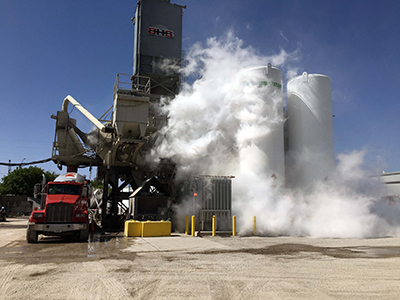Producers are investing in precision over tradition when it comes to cooling concrete
By Craig Yeack
What is control worth? In 1973, the visionary Bob Hawkins of Spence Concrete in McAllen, Texas jumped in with both feet. He was one of the first to purchase the 1150, the first all solid-state commercial concrete full batch controller from Alkon. This innovation replaced levers and wheels, and a guy who had forearms like Popeye the Sailor. The leap of faith was that tighter controls on batching would reduce costs and improve pricing power.
Hawkins’ gamble paid off for Spence and the entire industry, although it was not without growing pains. The “computer” was instructed by plastic cards, each representing a batch in 80 characters. The batchman would load a stack of cards in order, and each press of a button would produce a batch. Four decades later, technology innovator NITROcrete presents us with another debate about the value of control: Is there a better way to cool concrete?


THE ART AND SCIENCE OF COOLING
Hydration of portland cement is exothermic and throws off a lot of heat in two specific waves. In a hot ambient environment, think Death Valley, the added heat of hydration can quickly ruin the mechanical properties of the mix. Historically, chilled water for small temperature reduction or ice for more correction has been used to cool the constituents and save the day.
The problem with ice is control and safety. Typically, a driver—currently in critically short supply for our industry—has to climb up and down the rear ladder and add bags of ice. This increases the chances for injury. In terms of control, was that bag really 40 lbs., and did the driver really put in the right amount? Mistakes can quickly ruin the holy grail of quality control: the water-cement ratio.
What if chilled water or ice simply is not enough? After all, we are dealing with around 3,000 lbs. of rocks per cubic yard at say 100°F. Per ACI 305/6, cold water can knock off 1-4°F and ice up to 20°F, depending on melt, cement content, raw materials or other factors.
NITROcrete, based in Fort Collins, Colo., has devised a system by which coarse aggregate is sprayed with liquid nitrogen (LN2) at -320°F on the belt near where it is fed into a batch of concrete. Chilled water is about 35°F, and ice is about 20°F. It doesn’t take a mathematical genius to see that, pound for pound, LN2 packs a huge punch.
The company claims its system can cool aggregate to a desired temperature, up to 40°F reduction. Further, cooling coarse aggregate before batching allows for a slower, steady transfer of heat during the exothermic hydration cycle. In terms of pricing, the cost of ice is replaced by a charge for the dosage of liquid nitrogen added to the batch to achieve a given temperature reduction.
APPLYING FINANCES TO PHYSICS
The value proposition is clear for hot climates with thermally sensitive mixes and applications. The greater question is its feasibility for widespread use in the industry to replace chilled water and ice. LN2 and the system to disperse it are not free. Can that Mohammed Ali right hook of cooling power applied to coarse aggregate before batching, combined with better control and driver safety, compete with the low cost of ice?
According to Matthew Nazarenko, vice president for NITROcrete’s Eastern region, more than 100 concrete plants use the system globally. He says ice is roughly 10 cents per pound nationally and that cooling is accomplished at a similar price point when factoring labor, opportunity costs if the driver is needed to load ice, truck rentals, fuel, maintenance, time delays for loading, and safety incidents. Nazarenko also points out that the model is similar to admixtures in that all equipment is owned, operated and maintained by NITROcrete, which handles all service and delivery.
There are parallels between this new technology and Bob Hawkins’ visionary step with automated batching of concrete. He did this with little hard evidence about the future return on investment, but instead just “knew it was the right thing to do.” Producers who embrace a high-tech approach to cooling concrete in the interest of improving mix accuracy and driver safety may also end up like Hawkins: right on target.

Craig Yeack has held leadership positions with both construction materials producers and software providers. He is co-founder of BCMI Corp. (the Bulk Construction Materials Initiative), which is dedicated to reinventing the construction materials business with modern mobile and cloud-based tools. His Tech Talk column—named best column by the Construction Media Alliance in 2018—focuses on concise, actionable ideas to improve financial performance for ready-mix producers. He can be reached at [email protected].